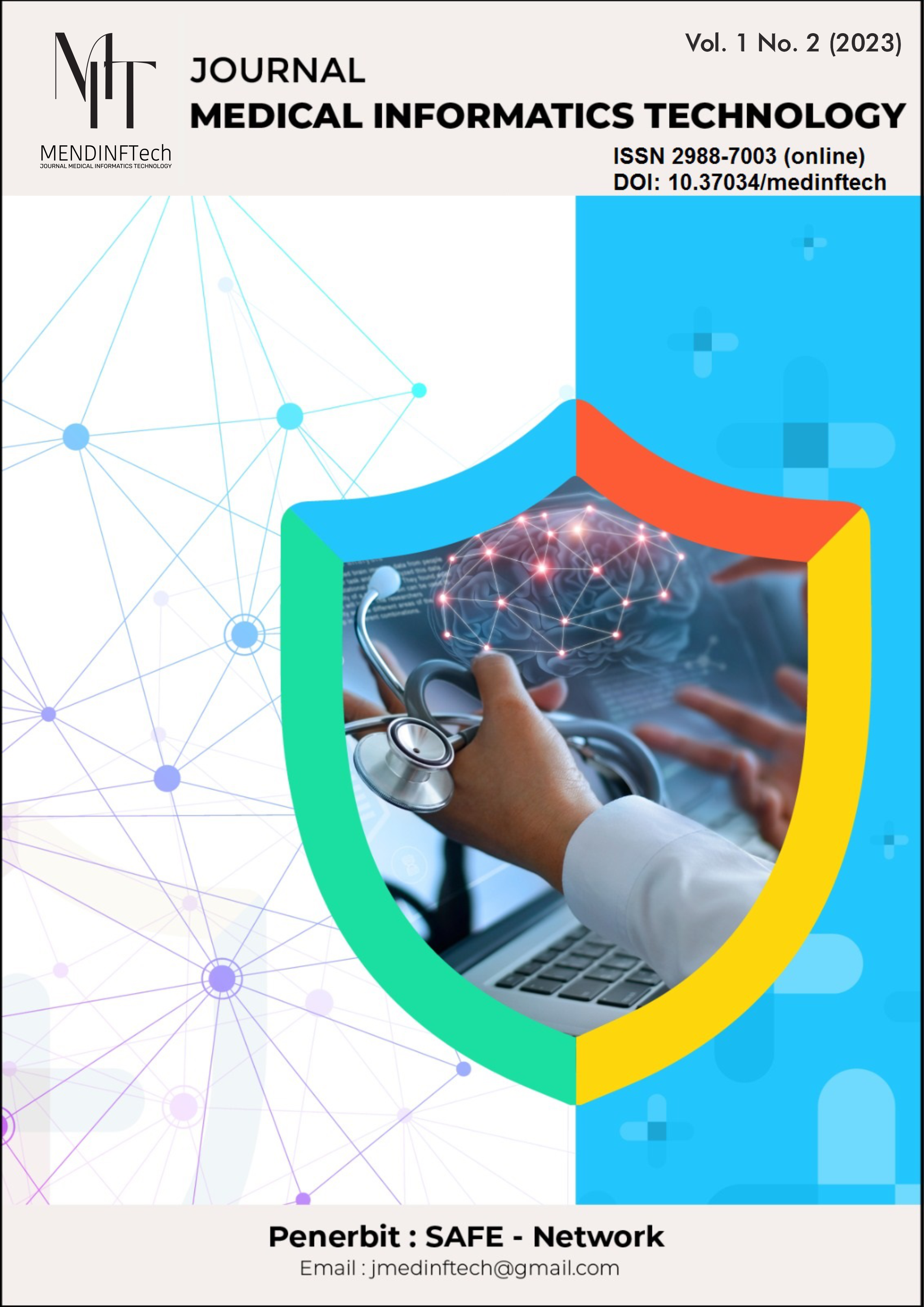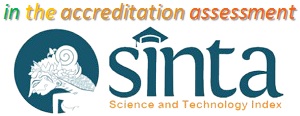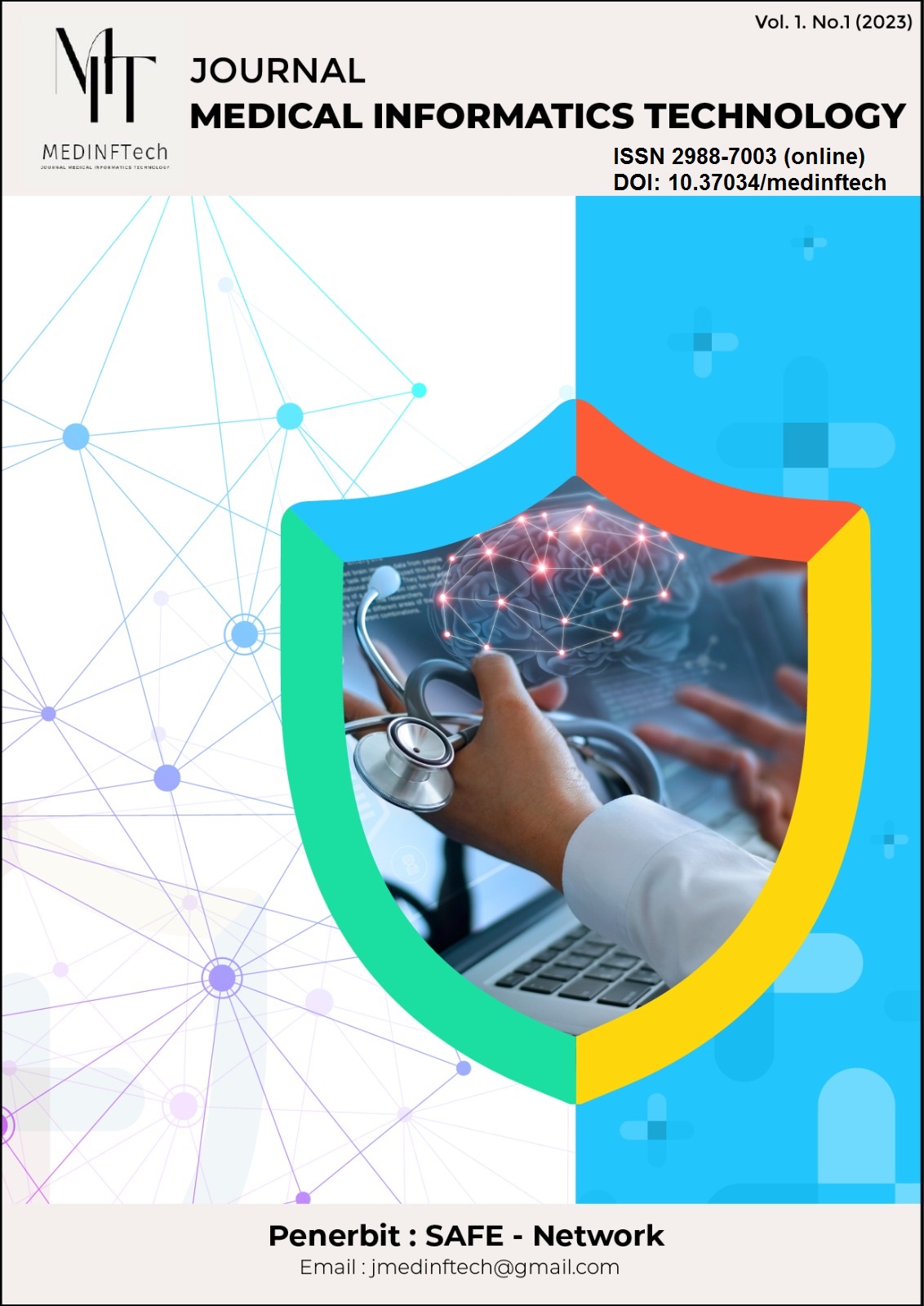Classification of Myopia Levels using Deep Learning Methods on Fundus Image
DOI:
https://doi.org/10.37034/medinftech.v1i2.8Keywords:
Myopia, Eye Disease, Classification, Augmentation, Deep LearningAbstract
Disorders of the eye or also known as eye disease is a condition that can affect vision for some people in their lifetime. There are 40 types of eye disorders or eye diseases, one of which is Myopia. Myopia is a visual disturbance that causes objects that are far away to appear blurry, but there is no problem seeing objects that are near. Myopia or nearsightedness is also known as minus eye. From this description, it is very important to conduct research in detecting eye diseases before the increase in eye minus and blindness. This study aims to classify myopic eye disease using the Deep Learning method with several different architectures, namely the VGG16, VGG19 and InceptionV3V3 models. Where the first is to distinguish normal and abnormal while the other is to classify with Augmented myopia image dataset and non augmented myopia image dataset obtained from the Retinal Fundus Multi-Disease Image Dataset (RFMID). In the implementation of the Deep Learning method using 20 Epochs. The results of the accuracy of the classification of eye diseases using the non augmented myopia image dataset are 66.0% for the VGG16 architectural model, then 95.99% for the VGG19 architectural model and 93.99% for the InceptionV3 architectural model and the accuracy results using the Augmented myopia image dataset are 97.53% for the VGG16 architectural model, 97.53% for the VGG19 architectural model and 99.50% for the InceptionV3 architecture model.
Downloads
References
F. N. Cahya, N. Hardi, D. Riana, and S. Hadiyanti, “Klasifikasi Penyakit Mata Menggunakan Convolutional Neural Network (CNN),” Sistemasi, vol. 10, no. 3, p. 618, 2021, doi: 10.32520/stmsi.v10i3.1248.
J. Ruiz-Medrano, E. Almazan-Alonso, I. Flores-Moreno, M. Puertas, M. García-Zamora, and J. M. Ruiz-Moreno, “The relationship between myopic choroidal neovascularization activity and perforating scleral vessels in high myopia,” Retina, vol. Publish Ah, pp. 204–209, 2021, doi: 10.1097/iae.0000000000003290.
World Health Organization, The Impact of Myopia and High Myopia: report of the joint World Health Organisation-Brian Holden Vision Institute Global Scientific Meeting on Myopia, no. March. 2015.
R. Du et al., “Deep Learning Approach for Automated Detection of Myopic Maculopathy and Pathologic Myopia in Fundus Images,” Ophthalmol. Retin., pp. 1–10, 2021, doi: 10.1016/j.oret.2021.02.006.
N. Széll et al., “Myopia-26, the female-limited form of early-onset high myopia, occurring in a European family,” Orphanet J. Rare Dis., vol. 16, no. 1, pp. 1–13, 2021, doi: 10.1186/s13023-021-01673-z.
P. Powar and C. R. Jadhav, “Retinal Disease Identification by Segmentation Techniques in Diabetic Retinopathy,” Lect. Notes Networks Syst., vol. 10, pp. 255–265, 2018, doi: 10.1007/978-981-10-3920-1_26.
B. B. Naik and R. Mariappan, “Classification of Eye Diseases Using Optic Cup Segmentation and Optic Disc Ratio,” IOSR J. Comput. Eng., vol. 18, no. 05, pp. 87–94, 2016, doi: 10.9790/0661-1805038794.
F. S. Ni’mah, T. Sutojo, and D. R. I. M. Setiadi, “Identification of Herbal Medicinal Plants Based on Leaf Image Using Gray Level Co-occurence Matrix and K-Nearest Neighbor Algorithms,” J. Teknol. dan Sist. Komput., vol. 6, no. 2, pp. 51–56, 2018, doi: 10.14710/jtsiskom.6.2.2018.51-56.
B. A. Varghese, S. Y. Cen, D. H. Hwang, and V. A. Duddalwar, “Texture Analysis of Imaging: What Radiologists Need to Know,” Ajr, no. 212, pp. 1–9, 2019.
L. Armi and S. Fekri-Ershad, “Texture image analysis and texture classification methods - A review,” vol. 2, no. 1, pp. 1–29, 2019, [Online]. Available: http://arxiv.org/abs/1904.06554.
G. Bruno and D. Antonelli, “Dynamic task classification and assignment for the management of human-robot collaborative teams in workcells,” Int. J. Adv. Manuf. Technol., vol. 98, no. 9–12, pp. 2415–2427, 2018, doi: 10.1007/s00170-018-2400-4.
D. Meijer, L. Scholten, F. Clemens, and A. Knobbe, “A defect classification methodology for sewer image sets with convolutional neural networks,” Autom. Constr., vol. 104, no. December 2018, pp. 281–298, 2019, doi: 10.1016/j.autcon.2019.04.013.
J. Zhang, Y. Xie, Q. Wu, and Y. Xia, “Medical image classification using synergic deep learning,” Med. Image Anal., vol. 54, pp. 10–19, 2019, doi: 10.1016/j.media.2019.02.010.
R. J. S. Raj, S. J. Shobana, I. V. Pustokhina, D. A. Pustokhin, D. Gupta, and K. Shankar, “Optimal feature selection-based medical image classification using deep learning model in internet of medical things,” IEEE Access, vol. 8, pp. 58006–58017, 2020, doi: 10.1109/ACCESS.2020.2981337.
S. Pachade et al., “Retinal Fundus Multi-disease Image Dataset (RFMiD),” 2020. doi: https://dx.doi.org/10.21227/s3g7-st65.
N. E. Khalifa, M. Loey, and S. Mirjalili, “A comprehensive survey of recent trends in deep learning for digital images augmentation,” Artif. Intell. Rev., no. 0123456789, 2021, doi: 10.1007/s10462-021-10066-4.
P. Hurtik, V. Molek, and J. Hula, “Data Preprocessing Technique for Neural Networks Based on Image Represented by a Fuzzy Function,” IEEE Trans. Fuzzy Syst., vol. 28, no. 7, pp. 1195–1204, 2020, doi: 10.1109/TFUZZ.2019.2911494.
R. Sarki, K. Ahmed, H. Wang, Y. Zhang, J. Ma, and K. Wang, “Image Preprocessing in Classification and Identification of Diabetic Eye Diseases,” Data Sci. Eng., vol. 6, no. 4, pp. 455–471, 2021, doi: 10.1007/s41019-021-00167-z.
Y. Zhang, J. M. Gorriz, and Z. Dong, “Deep learning in medical image analysis,” J. Imaging, vol. 7, no. 4, p. NA, 2021, doi: 10.3390/jimaging7040074.
G. Litjens et al., “A survey on deep learning in medical image analysis,” Med. Image Anal., vol. 42, no. December 2012, pp. 60–88, 2017, doi: 10.1016/j.media.2017.07.005.
S. Jia, S. Jiang, Z. Lin, N. Li, M. Xu, and Y. Shiqi, “A survey: Deep learning for hyperspectral image classification with few labeled samples, Neurocomputing,” Neurocomputing, vol. 448, pp. 179–204, 2021, doi: https://doi.org/10.1016/j.neucom.2021.03.035.
V. Shah, R. Keniya, A. Shridharani, M. Punjabi, J. Shah, and N. Mehendale, “Diagnosis of COVID-19 using CT scan images and deep learning techniques,” Emerg. Radiol., vol. 28, no. 3, pp. 497–505, 2021, doi: 10.1007/s10140-020-01886-y.
N. Calik, M. A. Belen, and P. Mahouti, “Deep learning base modified MLP model for precise scattering parameter prediction of capacitive feed antenna,” Int. J. Numer. Model. Electron. Networks, Devices Fields, vol. 33, no. 2, 2020, doi: 10.1002/jnm.2682.
J. Sultana, M. Usha Rani, and M. A. H. Farquad, “Student’s performance prediction using deep learning and data mining methods,” Int. J. Recent Technol. Eng., vol. 8, no. 1 Special Issue 4, pp. 1018–1021, 2019.
V. Sekar, Q. Jiang, C. Shu, and B. C. Khoo, “Fast flow field prediction over airfoils using deep learning approach,” Phys. Fluids, vol. 31, no. 5, 2019, doi: 10.1063/1.5094943.
A. Çinar and M. Yildirim, “Detection of tumors on brain MRI images using the hybrid convolutional neural network architecture,” Med. Hypotheses, vol. 139, no. February, p. 109684, 2020, doi: 10.1016/j.mehy.2020.109684.
K. Arisudana et al., “Sistem pendeteksi kerusakan luar angkutan umum,” pp. 175–187, 2020.
Downloads
Published
How to Cite
Issue
Section
License
Copyright (c) 2023 Journal Medical Informatics Technology

This work is licensed under a Creative Commons Attribution 4.0 International License.








